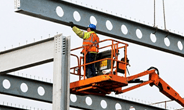Economy

Keys to Watch in March
Written by John Packard
March 3, 2014
The early sentiment has scrap prices dropping during the month of March but not as strong or as wide-spread as forecast a couple of weeks ago. Flows into the scrap yards have been impacted by the severe weather in the North and this is tempering the drop which, according to at least one SMU scrap source in Chicago, allowed some dealers to get the same prices as February.
A limited drop in scrap prices could be a positive for the industry and assist in stemming the drop in steel prices.
On the other side of the coin is spot iron ore prices in China. China steel making has been slowing and inventories of iron ore are quite high. The expectation is for iron ore to drop below $100 per dry metric ton from the $117 level being reported on 62% Fe by TSI at the end of February. Sliding iron ore prices will pressure domestic scrap and steel prices so we do need to watch iron ore as the month progresses.
AK Steel lost their Ashland blast furnace. The furnace is rated at 6,000 tons per day (although it was not working to capacity at the time when it went down). It is expected that the mill will lose approximately 100,000 tons of melt as repairs are being made. It will take most, if not all of the month of March to complete repairs and begin to bring the furnace back online.
The AK furnace outage has temporarily halted the price drop as the market weighs the impact to hot rolled, cold rolled and coated steels. Prior to going down our sources had advised that AK was taking some spot hot rolled business at numbers at the low end of our range ($620 per ton) or below.
We will need to watch lead times and order flows – especially to the mini-mills as they are the weakest mills at this time.
We will also watch the willingness of the domestic mills to negotiate pricing. During our last survey all products were found to be negotiable with cold rolled being the product with the most resistance and hot rolled the product where the domestic mills were most willing to negotiate.
Demand continues to be essentially the same as 2013. Any uptick in demand will put pressure on the mills to produce more steel which will mean higher prices.
However, at the same point in time we are forecasting 3 million+ tons of foreign steel to arrive on U.S. shores during February. We will watch carefully if March remains at that level (or higher) as foreign steel will put pressure on domestic mills to keep prices “in touch” (within range) with the domestic pricing.

John Packard
Read more from John PackardLatest in Economy

Steel groups welcome passage of budget bill
Steel trade groups praised the passage of the Big Beautiful Bill (BBB) in Congress on Thursday.

Industry groups praise Senate for passing tax and budget bill
The Steel Manufacturers Association and the American Iron and Steel Institute applauded the tax provisions included in the Senate's tax and budget reconciliation bill.

Chicago PMI dips 0.1 points in June
The Chicago Purchasing Managers Index (PMI) slipped 0.1 points to 40.4 points, in June.

Multi-family pullback drives housing starts to 5-year low in May
US housing starts tumbled in May to a five-year low, according to figures recently released by the US Census Bureau.

Architecture firms still struggling, ABI data shows
Architecture firms reported a modest improvement in billings through May, yet business conditions remained soft, according to the latest Architecture Billings Index (ABI) release from the American Institute of Architects (AIA) and Deltek.
